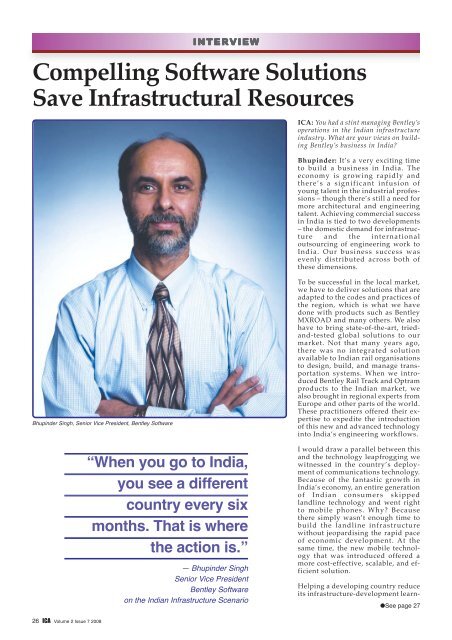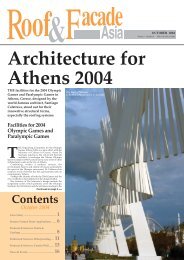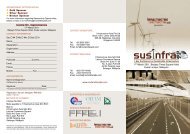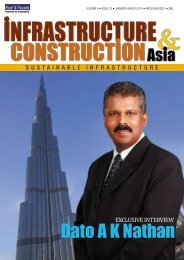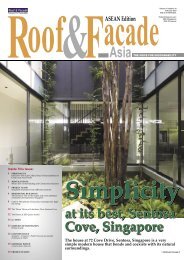Yangtze River Tunnel â A Project Of E&C ... - Roof & Facade
Yangtze River Tunnel â A Project Of E&C ... - Roof & Facade
Yangtze River Tunnel â A Project Of E&C ... - Roof & Facade
Create successful ePaper yourself
Turn your PDF publications into a flip-book with our unique Google optimized e-Paper software.
FINANCE & LEGAL<br />
●From page 12<br />
reduce to a minimum or<br />
even eliminate audit and inspection<br />
by the Employer.<br />
However, some Employers<br />
may feel uncomfortable with<br />
this, and such arrangements<br />
are unlikely to be acceptable<br />
in the public sector.<br />
As an alternative, audit<br />
and inspection may be carried<br />
out jointly or by independent<br />
consultants whose costs are<br />
shared. Where sub-contractors<br />
and suppliers are also<br />
parties to such arrangements,<br />
the cost savings can be substantial.<br />
Any reduction in audit<br />
and inspection procedures<br />
must however be balanced<br />
against the increased involvement<br />
of the Employer in establishing<br />
the partnering relationship.<br />
• Reduction in costs associated<br />
with disputes: Such<br />
costs are said to include not<br />
only those of outside consultants<br />
but also the internal<br />
costs associated with<br />
adversarial contract administration<br />
which requires a<br />
detailed paper trail to be<br />
prepared to position the<br />
parties for the defence or<br />
pursuit of claims.<br />
• Increased integration: For<br />
the contractor, there is a<br />
greater acceptance and understanding<br />
of its interest in<br />
the project. A co-operative<br />
environment allows the<br />
contractor’s project team to<br />
concentrate on finding the<br />
best solutions to the work<br />
scope, rather than pursuing<br />
claims. Under alliancing<br />
and some partnering arrangements<br />
the contractor<br />
has an ability to improve its<br />
profit margin, without adversely<br />
affecting the quality<br />
of work, by having the opportunity<br />
to share project<br />
profits.<br />
The partnering process<br />
The ethos behind partnering<br />
is that the client, designers<br />
and contractor work as a team<br />
from the outset, resolving disputes<br />
in a non-adversarial<br />
manner and sharing both the<br />
risk and rewards. In doing so,<br />
they reduce time and cost and<br />
improve quality of build,<br />
without sacrificing profits.<br />
These partnering concepts are<br />
not new but simply reflect<br />
good working practices already<br />
developed through<br />
long-term relationships.<br />
Basics of Partnering<br />
The basics of the partnering<br />
procession can be summarised<br />
in three stages, mainly:<br />
• Agreeing to use partnering.<br />
There needs first to be an<br />
understanding of what<br />
partnering means to those<br />
involved. This can be<br />
achieved by education of<br />
and commitment from all<br />
the participants, including<br />
the top management of<br />
these organisations.<br />
• Setting up an initial<br />
partnering workshop to address<br />
the various issues including<br />
agreeing on the objectives<br />
and the means of<br />
resolving any problems.<br />
• Carrying out the construction<br />
work using further<br />
partnering workshops to<br />
ensure the team steadily<br />
improves and teamwork is<br />
maintained. These further<br />
workshops, the development<br />
of periodic evaluation<br />
process and feedback are all<br />
necessary.<br />
The partnering process<br />
must involve all participants<br />
and it is important that everyone<br />
from senior manager to operatives<br />
on site is engaged in<br />
the process. Workshop are important<br />
components of the success<br />
or otherwise of partnering<br />
as they establish the intention<br />
at the inception stage with all<br />
the participants. The use of a<br />
few contractors, designers etc<br />
means that the supply chain<br />
gains knowledge and experience<br />
of the client’s business and<br />
is therefore in a much better<br />
position to produce “best<br />
value” for the clients.<br />
The selection of the participants<br />
is critical and may<br />
start with a cultural audit to<br />
ensure that they possess the<br />
appropriate characteristics<br />
and attributes.<br />
Key aspects that underpin<br />
partnering<br />
These include:<br />
• Trust and respect<br />
• Commitment to mutual objectives<br />
• Co-operation through<br />
teamwork<br />
• Interdependence<br />
• Communication<br />
• Risk Identification and<br />
Management<br />
• Continuous Improvement<br />
• Joint Problem Solving<br />
When setting up<br />
partnering arrangements, one<br />
must have a clear appreciation<br />
of what is required under<br />
each of these headings. Notwithstanding<br />
that during the<br />
construction process mistakes<br />
will be made, rather than go<br />
straight to the contract there<br />
is the understanding that the<br />
participants will attempt to<br />
revolve the problem without<br />
attributing blame. It is based<br />
on the philosophy that the delivery<br />
of the project is the primary<br />
motivator and achieving<br />
this to best advantage will<br />
be in the interests of the team,<br />
if not directly and in the short<br />
term, certainly in the wider<br />
and longer term. Currently,<br />
this paradigm of working is<br />
still alive in the work processes<br />
in Singapore. For example,<br />
if potential cash flow issues<br />
arise, the Contractor may<br />
seek assistance from the Employer<br />
to waive certain contractual<br />
rights such as higher<br />
performance bond percentage.<br />
However, these informed<br />
structures vary from project<br />
to project, team to team and<br />
it also greatly depends on the<br />
objectives of the Contractor,<br />
that is to say, the enter into a<br />
project for overall cash flow<br />
reasons for his company<br />
(hence being very shrewd in<br />
working attitudes).<br />
The benefits of good<br />
teamwork are self-evident in<br />
that each other’s roles and requirements<br />
are well understood.<br />
This in turn feeds into<br />
the partnering process which<br />
then provides better value<br />
products within shorter<br />
timescales and reduced industrial<br />
and contractual disputes.<br />
However, unless the<br />
issue and allocation of costs<br />
is addressed at the outset in a<br />
non-confrontational way<br />
there is potential for major<br />
problems to arise. Furthermore,<br />
where parties are contemplating<br />
entering into<br />
partnering arrangements they<br />
should notify their insurers<br />
before doing so.<br />
Long Term Partnering<br />
Long-term partnering concerns<br />
two or more companies<br />
working together over a period<br />
of time to achieve continuous<br />
improvement in areas<br />
such as cost reduction, speed<br />
to market and improvements<br />
in quality and safety.<br />
Parties may operate such<br />
relationships merely on the<br />
basis of regular repeat working<br />
over a series of projects<br />
without any contract governing<br />
the terms upon which the<br />
long-term relationship should<br />
be conducted. Instead, the extent<br />
of co-operation and communication<br />
between the parties<br />
may be contained in a<br />
partnering charter or nonbinding<br />
partnering agreement<br />
as addressed above.<br />
As negotiation and joint<br />
working continues and<br />
partnering relationship matures,<br />
new goals and different<br />
converging interests are likely<br />
to emerge and the initial<br />
agreement and bases for the<br />
relationship may require<br />
amendment to reflect these<br />
changes.<br />
In the past, parties have<br />
simply fallen into relationships<br />
that resemble long-term<br />
partnership arrangements.<br />
The parties’ interests have<br />
aligned and a relationship<br />
based on trust has developed<br />
as a result of working together<br />
for a long time. The<br />
oldest known partnering arrangement<br />
in the UK is the<br />
long-term relationship between<br />
Bovis and Marks &<br />
Spencer, which started in<br />
1926. The terms of this relationship<br />
were not contained<br />
in writing at any stage, nor<br />
were there any financial incentive<br />
schemes in place. It<br />
was relationship based purely<br />
on the co-operation of the parties<br />
and the exchange of information,<br />
personnel and skills.3<br />
It is often asserted that<br />
long term partnering provides<br />
parties with benefits<br />
greater than other forms of<br />
partnering because it allows<br />
time for continuous improvement.<br />
It is argued that the<br />
benefits to be gained in terms<br />
of cost and time savings increase<br />
with each new project<br />
because teething problems<br />
are resolved and lessons are<br />
learnt from difficulties encountered<br />
on previous<br />
projects. Even so, the increasing<br />
use of other forms of<br />
partnering has made it apparent<br />
that each form offers parties<br />
specific benefits that may,<br />
depending on the project and<br />
desired outcomes, prove<br />
more beneficial than that of<br />
continuous improvement under<br />
long-term partnering.<br />
Advantages of long term<br />
partnering include reduced<br />
transaction costs over time<br />
achieved by improved<br />
efficiencies and sharing of resources.<br />
Repeat working<br />
leads to standardisation in<br />
working practices and procedures<br />
and, when possible,<br />
design and construction solutions.<br />
The length of the relationship<br />
creates more opportunity<br />
to effect a cultural<br />
change and overcome any initial<br />
resistance to the<br />
●See page 15<br />
14 ICA Volume 2 Issue 7 2008


